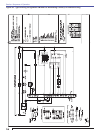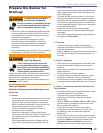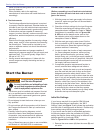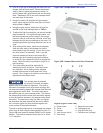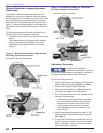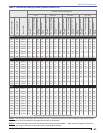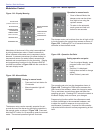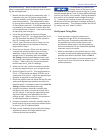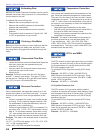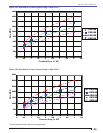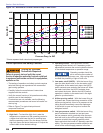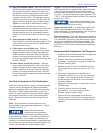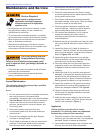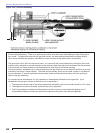
24
Estimating Rate
Manifold to Furnace Pressure information can be used to
estimate the burner’s fi ring rate when it is not possible to
clock a meter for the rate.
To estimate the burner’s fi ring rate:
Measure the furnace pressure over fi re
Measure the manifold pressure (at the manifold
pressure test connection).
Subtract the furnace pressure from the manifold
pressure
Compare the result to the data in Figures 14A, 14B,
or 14C as appropriate for your burner.
Clocking a Gas Meter
Before you clock the meter you must make sure that the
burner is operating at a steady rate, and that it is the
only thing that is using gas that would fl ow through the
meter.
Uncorrected Flow Rate
Locate the dial that moves the fastest and determine
how many cubic feet are represented by one
revolution of its dial.
Use your watch for timing and observe how many
cubic feet are used in one minute.
Multiply by 60
Example: The dial is a one cubic foot dial, and goes
around 7 ½ times in one minute. That gives 7.5 cubic
feet per minute. Multiply by 60 to get 450 cubic feet per
hour (CFH) as your uncorrected fl ow rate.
Pressure Correction
Gas is compressible, the higher the pressure on it, the
smaller the number of cubic feet it occupies. To correct
for that you will need to know the gas pressure at the
meter.
If there’s a gauge at the meter, read it while the gas
is fl owing. (If not, measure the gas pressure in the
line downstream of the meter before any valves or
regulators, with no gas fl owing.)
Convert the gas pressure to PSI if you measure it in
any other units. (1 PSI = 27.7 inches water column)
Add 14.7 to the meter pressure, divide their sum by
14.7, and multiply that result times the uncorrected
fl ow rate to obtain the pressure corrected fl ow rate.
Example: The meter in the example above is operating
at 14” WC.
14 / 27.7 = 0.5 PSI at the gauge; 14.7 + 0.5 =15.2; 15.2 /
14.7 = 1.034 correction factor;
1.034 x 450 = 465 CFH corrected for pressure
○
○
○
○
○
○
○
○
○
○
Temperature Correction
Gas volume also changes with the temperature of the
gas. Most gas meters are temperature compensated.
They say so on the face of the index and don’t require
temperature correction. The temperature we correct to
is 60° F. That’s close to the temperature of the ground,
so usually it’s not necessary to correct for temperature
from underground lines.
Measure the gas temperature at the meter.
Add 460 to the gas temperature and divide 520 by
the result to obtain the correction factor.
Multiply the pressure corrected fl ow rate times the
temperature correction factor.
Example: The meter in the example is connected to
an above ground line on a hot day and shows 100°
F gas temperature. 460 + 100 = 560; 520 / 560 =
0.929; 465 x 0.929 = 432 CFH corrected for pressure
and temperature. This fi gure is often called SCFH (for
standard cubic feet per hour).
BTU’s and MBH
Natural Gas
The BTU content of natural gas varies from one location
to another, and even from day to day at a fi xed location.
For fi ring estimates it is usually assumed to be 1000
BTU’s per standard cubic foot.
To calculate BTU/Hr fi ring rates multiply SCFH times
1000.
Example: 432 SCFH x 1000 = 432,000 BTU/Hr.
MBH stands for thousands of BTU’s per hour. Since
1 cubic foot of natural gas contains 1000 BTU, 1 MBH
equals 1 SCFH of gas fl ow.
Example: 432 SCFH = 1,080 MBH
LP (Liquifi ed Petroleum) Gas
The BTU content of LP gas varies with the relative
quantities of propane and butane in each delivery of gas
and changes as liquid level in the tank falls. For fi ring
estimates it is usually assumed to be 2,500 BTUs per
standard cubic foot.
To calculate BTU/Hr fi ring rates multiply SCFH times
2,500.
Example: 432 SCFH x 2500 = 1,080,000 BTU/Hr.
MBH stands for thousands of BTU’s per hour. Since 1
cubic foot of propane gas contains 2,500 BTU, 1 MBH
equals 0.4 SCFH of gas fl ow.
Example: 432 SCFH = 1,080 MBH
○
○
○
Section: Start the Burner



